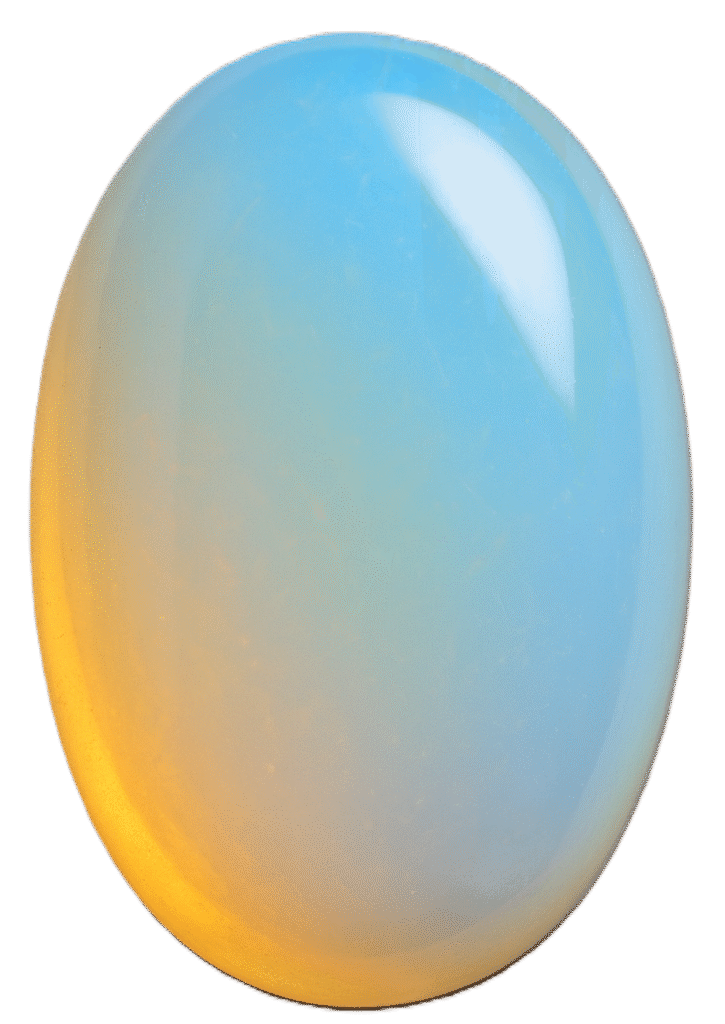
The name Opalite derives from the resemblance this man-made glass has to natural opal, from which it borrows both its luminous quality and ethereal charm. It is also commonly referred to as Tiffany Stone, Sea Opal Glass, Opalised Glass, or Argent Opal. Despite its synthetic nature, its beauty and energetic resonance have earned it a cherished place among crystal enthusiasts and metaphysical practitioners.
Composition, Physical Characteristics, and Varieties
Opalite is a man-made glass material composed primarily of silica, dolomite, and metal oxides fused under high temperatures. The result is a translucent or milky stone that displays a soft, opalescent glow, shifting between blue, white, and golden hues depending on the light.
Its key characteristics include:
- Hardness: Around 5.5–6 on the Mohs scale.
- Lustre: Glassy and vitreous.
- Transparency: Translucent to semi-transparent.
- Colour: Ranges from milky white to pale blue, often with a yellow-orange or peach tint under artificial light.
Varieties of Opalite include:
- Natural Opalite (Common Opal): A naturally occurring mineral form of opal without play-of-colour, found in some global deposits.
- Synthetic Opalite: The most common and widely available form, known for its glowing, moon-like translucence.
Geographical Locations
Natural Opalite, or common opal, can be found in regions such as Australia, Brazil, Mexico, the United States (Nevada and Oregon), Slovakia, and Tanzania. The synthetic version, however, is manufactured primarily in China and Indonesia, where skilled artisans create polished stones, spheres, and jewellery pieces for the global market.
Archaeological and Significant Finds
While synthetic Opalite has no ancient archaeological roots, its natural counterpart—common opal—has been used by civilisations for thousands of years. The Romans prized opals as symbols of love and hope, while ancient Greeks believed the gem bestowed foresight and prophecy.
In modern times, the invention of Opalite glass in the 20th century introduced a new era of mystical and decorative use. It quickly became a popular gemstone substitute, appreciated for its affordable beauty and gentle energy.
Historical and Current Usage
Historically, natural opal was worn as a talisman for emotional balance and protection. In contrast, modern Opalite is widely used in meditation practices, energy healing, and jewellery making.
Today, Opalite adorns pendants, bracelets, and home décor pieces, and is frequently used in crystal grids and Reiki healing sessions to calm emotions and stabilise moods. Its enchanting luminescence makes it a favourite among artists, spiritual healers, and collectors alike.
Interesting Facts
- When placed under light, Opalite radiates a mesmerising blue glow, earning it the nickname “the Tiffany Stone”.
- It is often mistaken for natural opal, yet is distinguished by its uniform colour and glassy texture.
- Despite being synthetic, many believe Opalite carries genuine energetic properties due to its vibrational resonance with the emotional body.
- The stone is sometimes called the “Merchant’s Stone”, believed to bring business success and smooth communication in the workplace.
Folklore, Superstition, Legends, and Tales
In metaphysical lore, Opalite is considered a stone of transitions—guiding one through change and transformation with calm assurance. It is said to bridge the gap between the physical and spiritual realms, acting as a beacon of light during times of uncertainty.
Some traditions associate Opalite with the moon and ocean spirits, symbolising serenity and emotional fluidity. It is believed that gazing into its soft glow helps release fear, encourage self-expression, and promote inner peace.
Mystical Healing Properties
Opalite is celebrated for its gentle yet powerful energy, promoting:
- Emotional Healing: Soothes anxiety, stabilises mood swings, and helps overcome fatigue or emotional exhaustion.
- Spiritual Growth: Enhances meditation, opens the third eye, and deepens connection with higher consciousness.
- Communication: Aids in clear expression of thoughts and feelings, making it beneficial for relationships and professional interactions.
- Transformation: Supports transitions by promoting acceptance and optimism.
Links with Astrology and the Zodiac
Opalite resonates most strongly with Cancer, Pisces, and Libra—signs connected to emotional depth, intuition, and harmony.
- Cancer: Encourages emotional balance and strengthens empathy.
- Pisces: Amplifies intuition and spiritual awareness.
- Libra: Promotes harmony in communication and relationships.
It also carries subtle lunar energy, making it particularly potent during full moon rituals or meditation.
The Chakra System
Opalite primarily aligns with the Third Eye Chakra (Ajna) and Crown Chakra (Sahasrara). Its soothing vibrations help open the mind to higher intuition and enhance spiritual insight. Additionally, it gently activates the Throat Chakra (Vishuddha), aiding in honest and heartfelt communication.
Use as a Birthstone and for a Wedding Anniversary
Although not a traditional birthstone, Opalite is often associated with October, sharing symbolic resonance with opal. It represents hope, faith, and clarity of emotion.
It also makes a meaningful gift for the 19th wedding anniversary, symbolising enduring love, understanding, and renewed emotional connection.
Crystals That Work Well with Opalite
Opalite pairs beautifully with stones that share its soothing and spiritual energy, such as:
- Amethyst – enhances meditation and intuition.
- Moonstone – amplifies emotional healing and feminine energy.
- Clear Quartz – boosts clarity and amplifies energy flow.
- Lapis Lazuli – encourages wisdom and communication.
Crystals to Avoid Pairing with Opalite
Avoid pairing Opalite with overly grounding or intense stones that may counter its delicate frequency, such as:
- Obsidian – may overshadow Opalite’s gentle energy.
- Hematite – can neutralise its uplifting vibration.
- Black Tourmaline – too grounding for Opalite’s ethereal essence.
Conclusion
Opalite, though man-made, embodies the serenity, mystery, and grace of natural gemstones. With its soft glow and tranquil energy, it serves as a bridge between the physical and spiritual worlds, offering peace, transformation, and clarity. Whether used in meditation, worn as jewellery, or cherished for its aesthetic charm, Opalite remains a radiant symbol of emotional healing and spiritual evolution.
